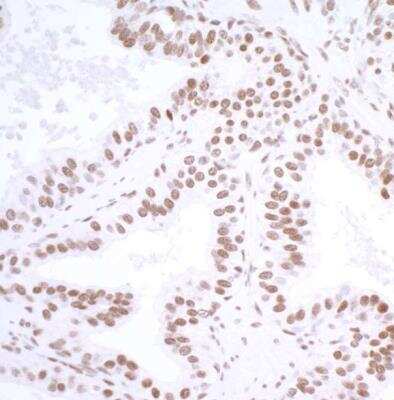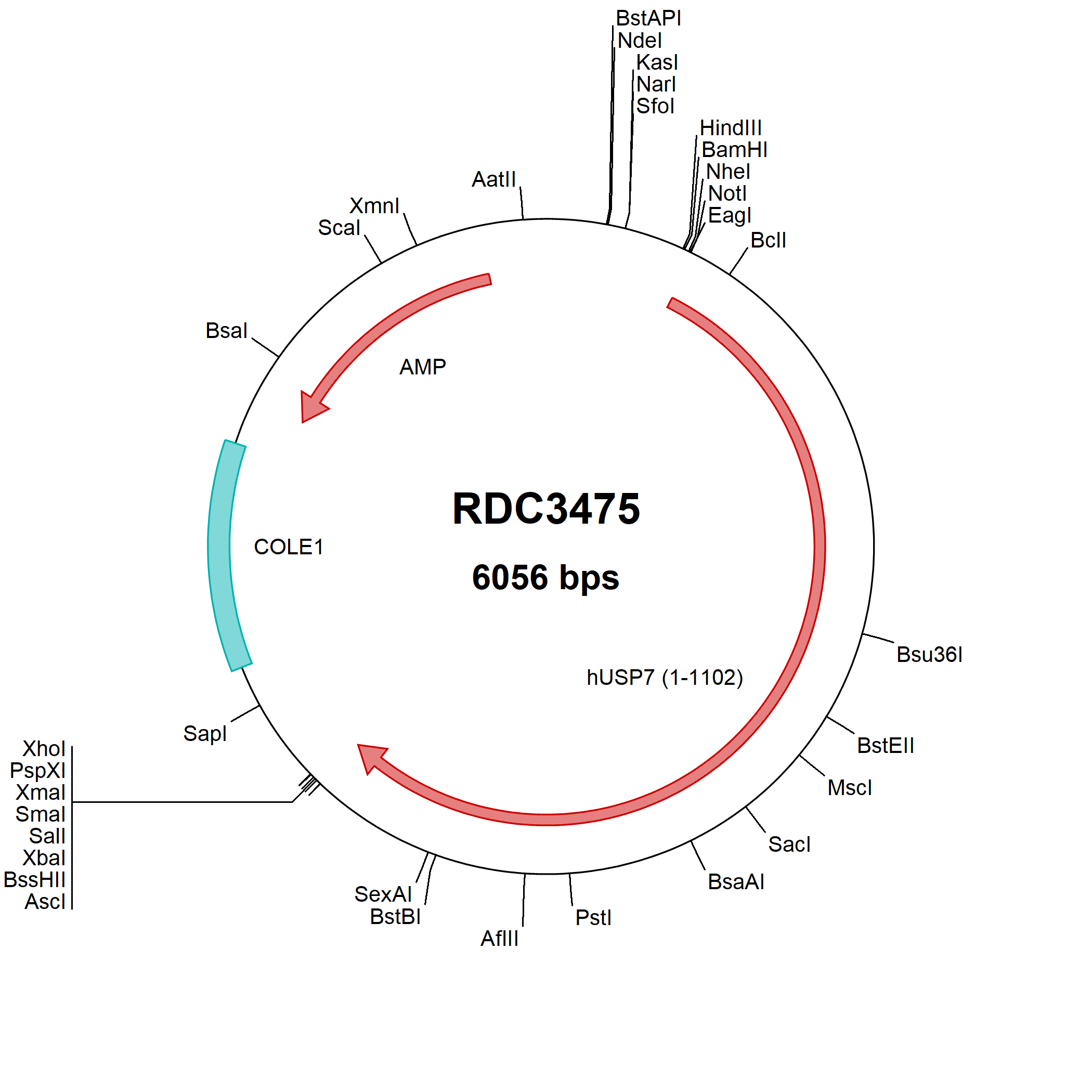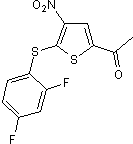USP7 Products
Ubiquitin Specific Peptidase 7 (USP7), also known as Herpes Virus-associated Ubiquitin Specific Protease (HAUSP), is a widely expressed deubiquitinating enzyme belonging to the peptidase C19 family. It has a predicted molecular weight of 130 kDa. Human USP7 is 1102 amino acids (aa) in length and shares 99% aa sequence identity with the mouse and rat orthologs. USP7 consists of a cysteine peptidase core (aa 208-560) that is flanked by an N-terminal TRAF-like domain (aa 50-205) and two C-terminal protease-resistant domains (aa 622-801 and 885-1061). USP7 can be phosphorylated at Ser18 and Ser963 and ubiquitinated at Lys869. USP7 was initially identified as a p53-interacting protein that deubiquitinates p53, thereby stabilizing the protein and inducing p53-dependent cell growth arrest and apoptosis. USP7 also targets the p53 regulatory proteins MDM2, MDMX, and Daxx, the epigenetic regulator Histone 2B, and the transcription factor FoxO4. Additionally, USP7 interacts with the HSV-1 immediate early protein ICP0, contributing to the stabilization and transactivation capability of ICP0 during HSV-1 infection.
133 results for "USP7" in Products
133 results for "USP7" in Products
USP7 Products
Ubiquitin Specific Peptidase 7 (USP7), also known as Herpes Virus-associated Ubiquitin Specific Protease (HAUSP), is a widely expressed deubiquitinating enzyme belonging to the peptidase C19 family. It has a predicted molecular weight of 130 kDa. Human USP7 is 1102 amino acids (aa) in length and shares 99% aa sequence identity with the mouse and rat orthologs. USP7 consists of a cysteine peptidase core (aa 208-560) that is flanked by an N-terminal TRAF-like domain (aa 50-205) and two C-terminal protease-resistant domains (aa 622-801 and 885-1061). USP7 can be phosphorylated at Ser18 and Ser963 and ubiquitinated at Lys869. USP7 was initially identified as a p53-interacting protein that deubiquitinates p53, thereby stabilizing the protein and inducing p53-dependent cell growth arrest and apoptosis. USP7 also targets the p53 regulatory proteins MDM2, MDMX, and Daxx, the epigenetic regulator Histone 2B, and the transcription factor FoxO4. Additionally, USP7 interacts with the HSV-1 immediate early protein ICP0, contributing to the stabilization and transactivation capability of ICP0 during HSV-1 infection.
| Reactivity: | Human, Mouse |
| Details: | Rabbit IgG Polyclonal |
| Applications: | IHC, WB, ICC/IF, IP |
| Source: | Sf 21 (baculovirus) |
| Accession #: | Q93009.2 |
| Applications: | EnzAct |
| Reactivity: | Human, Mouse, Rat |
| Details: | Mouse IgG1 Monoclonal Clone #OTI1F12 |
| Applications: | IHC, WB, Flow |
Recombinant Monoclonal Antibody
| Reactivity: | Human, Mouse, Rat |
| Details: | Rabbit IgG Monoclonal Clone #3J7G1 |
| Applications: | IHC, WB |
Recombinant Monoclonal Antibody.
| Reactivity: | Human, Mouse |
| Details: | Rabbit IgG Monoclonal Clone #BLR072G |
| Applications: | IHC, WB, ICC/IF, Flow, IP |
Recombinant monoclonal antibody expressed in HEK293F cells
| Reactivity: | Human |
| Details: | Rabbit IgG Monoclonal Clone #7F10 |
| Applications: | IHC, WB, ELISA, ICC/IF |
| Reactivity: | Human |
| Details: | Mouse IgG2A Monoclonal Clone #06 |
| Applications: | IHC |
| Reactivity: | Human |
| Details: | Mouse IgG2B Monoclonal Clone #6512 |
| Applications: | WB, ICC/IF, IP |
| Reactivity: | Human |
| Details: | Mouse IgG2A Monoclonal Clone #03 |
| Applications: | ELISA, Flow |
| Applications: | WB |
| Reactivity: | Human |
| Details: | Rabbit IgG Polyclonal |
| Applications: | IHC |
| Applications: | AC |
| Reactivity: | Human |
| Details: | Mouse IgG2A Monoclonal Clone #06 |
| Applications: | IHC |
| Reactivity: | Human |
| Details: | Mouse IgG2A Monoclonal Clone #03 |
| Applications: | ELISA, Flow |
| Reactivity: | Human |
| Details: | Mouse IgG2A Monoclonal Clone #06 |
| Applications: | IHC |
| Reactivity: | Human |
| Details: | Mouse IgG2A Monoclonal Clone #06 |
| Applications: | IHC |
| Reactivity: | Human |
| Details: | Mouse IgG2A Monoclonal Clone #03 |
| Applications: | ELISA, Flow |
| Reactivity: | Human |
| Details: | Mouse IgG2A Monoclonal Clone #06 |
| Applications: | IHC |
| Reactivity: | Human, Mouse, Rat |
| Details: | Mouse IgG1 Monoclonal Clone #OTI1F12 |
| Applications: | IHC, WB, Flow, CyTOF-ready |
| Reactivity: | Human, Mouse |
| Details: | Rabbit IgG Polyclonal |
| Applications: | IHC, WB, ICC/IF, IP |
| Reactivity: | Human, Mouse |
| Details: | Rabbit IgG Polyclonal |
| Applications: | IHC, WB, ICC/IF, IP |
| Reactivity: | Human, Mouse |
| Details: | Rabbit IgG Polyclonal |
| Applications: | IHC, WB, ICC/IF, IP |
Selective USP7 inhibitor
| Chemical Name: | 7-Chloro-9-oxo-9H-indeno[1,2-b]pyrazine-2,3-dicarbonitrile |
| Purity: | ≥98% (HPLC) |
USP7 inhibitor
| Chemical Name: | 1-[5-[(2,4-Difluorophenyl)thio]-4-nitro-2-thienyl]-ethanone |
| Purity: | ≥99% (HPLC) |

![Western Blot: USP7 Antibody [NB100-513] Western Blot: USP7 Antibody [NB100-513]](https://resources.bio-techne.com/images/products/USP7-Antibody-Western-Blot-NB100-513-img0004.jpg)


![Western Blot: USP7 Antibody (OTI1F12) [NBP2-01544] Western Blot: USP7 Antibody (OTI1F12) [NBP2-01544]](https://resources.bio-techne.com/images/products/USP7-Antibody-1F12-Western-Blot-NBP2-01544-img0002.jpg)
![Western Blot: USP7 Antibody (3J7G1) [NBP3-16188] Western Blot: USP7 Antibody (3J7G1) [NBP3-16188]](https://resources.bio-techne.com/images/products/USP7-Antibody-3J7G1-Western-Blot-NBP3-16188-img0004.jpg)


![Immunohistochemistry: USP7 Antibody (7F10) [NBP3-26258] - USP7 Antibody (7F10)](https://resources.bio-techne.com/images/products/nbp3-26258_rabbit-usp7-mab-7f10-262202415253324.jpg)
![Immunohistochemistry-Paraffin: USP7 Antibody (06) [NBP3-06428] Immunohistochemistry-Paraffin: USP7 Antibody (06) [NBP3-06428]](https://resources.bio-techne.com/images/products/USP7-Antibody-06-Immunohistochemistry-Paraffin-NBP3-06428-img0001.jpg)
![Western Blot: USP7 Antibody (6512) [NBP2-43619] Western Blot: USP7 Antibody (6512) [NBP2-43619]](https://resources.bio-techne.com/images/products/USP7-Antibody-6512-Western-Blot-NBP2-43619-img0001.jpg)
![Immunocytochemistry/ Immunofluorescence: USP7 Antibody (03) [NBP3-06427] Immunocytochemistry/ Immunofluorescence: USP7 Antibody (03) [NBP3-06427]](https://resources.bio-techne.com/images/products/USP7-Antibody-03-Immunocytochemistry-Immunofluorescence-NBP3-06427-img0001.jpg)
![Western Blot: USP7 Overexpression Lysate [NBL1-17671] Western Blot: USP7 Overexpression Lysate [NBL1-17671]](https://resources.bio-techne.com/images/products/USP7-Overexpression-Lysate-Adult-Normal-Western-Blot-NBL1-17671-img0002.jpg)
![Immunohistochemistry-Paraffin: USP7 Antibody [NBP1-83293] Immunohistochemistry-Paraffin: USP7 Antibody [NBP1-83293]](https://resources.bio-techne.com/images/products/USP7-Antibody-Immunohistochemistry-Paraffin-NBP1-83293-img0004.jpg)



